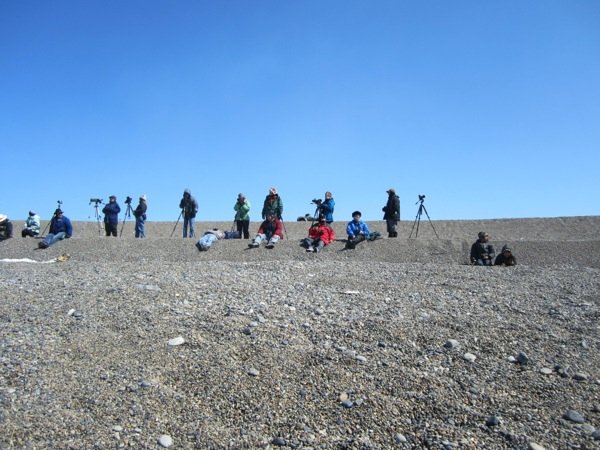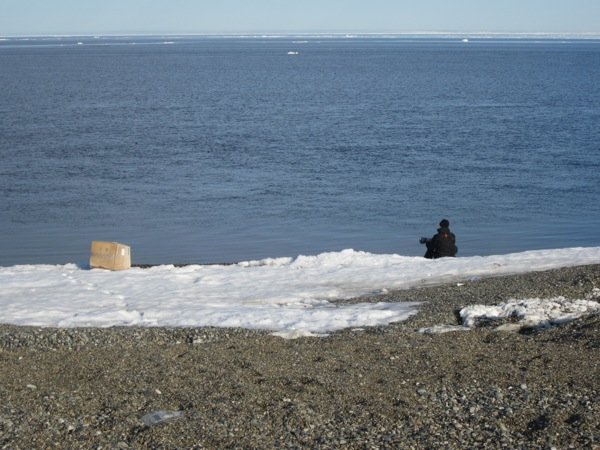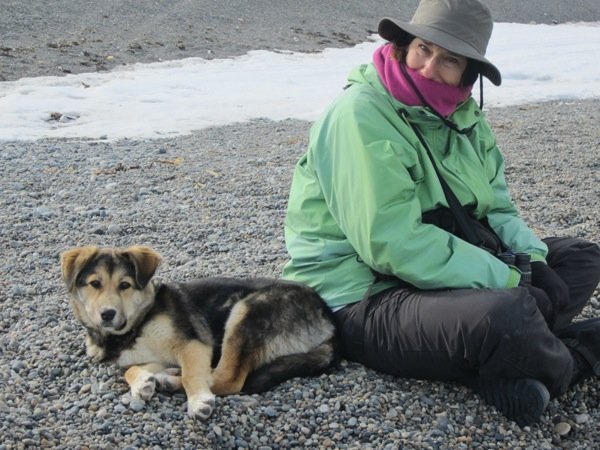Ocean Watch



As I sat on the gravel beach in Gambell, looking at the ocean and watching the stream of Alcids flying by, I thought: this is the best reality TV in the world. I rarely watch TV, unless my Tivoli friends show up wanting to watch a basketball, football or baseball game. Then the TV goes on, someone finds some food, a beer appears. The TV is the center, but not really. Our easy friendship is the center; this makes me ridiculously happy.
This TV watching made me happy in a different way. First of all, the viewing was outside, standing or seated on the gravel (though I do love loafing on my couch with friends). People shuffled around as backs got sore. And, it involved watching something truly beautiful: thousands of birds nearing the northern end of their migration.
For many birds, migration involves following a coastline or waterway. This is one reason living along the Hudson River is fun--birds follow the river north and south. I always look forward to those evenings in spring when the Brant head north, and then in fall when they start south. They create a nice rhythm to the year. Here, those birds that nest in the high Arctic pass the tip of land of St. Lawrence Island in the Bering Sea. Most have made a journey of thousands of miles. Some stop in Gambell, like the Snow Bunting and Lapland Longspur. But most fly by. We were there to see the these intrepid travelers. It was like an Easter Egg hunt, only we didn't have to move.
All I had to do was stare out at the wide water. In the distance: Chukotsk Peninsula, Russia. Ice flows floated north, with speed, telling me the currents offshore are strong. The water was--how to describe the cold? Imagine water made of just-melted ice. The tips of my fingers tingled.
As we stood and watched, a dog would join us, playing with a piece of garbage that drifted down from the dump. Or, chew on a crab found amidst the gravel. At times children would join us, chattering away while we stood and watched the ocean. They didn't speak with us, but with each other, recounting stories as children do.
Identifying birds on the wing isn't easy--something I will never be good at--but after a while I got the hang of some of them--enough that I could tell when something special was coming into view (something special like a yellow-billed loon). The Thick-billed Murres flew in formation, their football shaped black and white bodies distinct. Often they were led by a Horned or Tufted Puffin, visible with those chunky orange bills. The little auklets flew in groups, often low to the water.
So we all counted on our leaders Kevin and David to call out what they saw and be sure to note the special birds.
"Spectacled Eider!" Kevin called and everyone scrambled for the scopes. The birds, a pair, made a quick stop so everyone could admire them. And, of course, some wanted to check these birds off of their life lists.
As I enter this strange and wonderful world of birding I'm always thinking about what it is I enjoy, what compels me. The lists do not excite me, even though I write everything down (this is more a writer's tick). Standing on the shoreline watching birds fly by isn't my idea of good birding--I like to walk along trails, into mountains, and then spend time looking closely at a bird, noting eyes and feathers and the change of color in light. Standing on the shore contemplating migration and watching the stream of birds was fun, though; watching Ocean TV is fun.
In the distance a whale blew, then breached. We all oohed, just like my friends in Tivoli do when the ball is hit out of the ball park.
photos above: VENT Ocean Watch joined by two local boys; Peter Schoenberger waiting to photograph passing birds; Tracy making friends with a local dog.
Boneyards



When you read about people birding Gambell (and that is the only reason for someone to visit this village) they write about birding the bone yards. I had trouble picturing what this might mean. But the first thing you see when you get off a flight into Gambell is a bone yard. It is (no surprise here) a mess of bones--whale, walrus, seal--as well as garbage. What this creates is a texture to the earth not like the rest of the village, which is all gravel. Thousands of years of decomposed animal bones and flesh make a dirt-like compost that support some plants--Arctic sage, for instance. But deep in these bone yards lie hidden treasures: fossilized bones, and sometimes fossilized ivory. The locals dig into the rich material looking for these scraps that they then carve and sell.
What birders love about this is that birds--migrants often blown off course, often pushed over from Russia--take cover in these pits. So we walk through and around these pits, hoping to flush up an unsuspecting, disoriented bird. Walking through a bone yard is a remarkable experience. I was intent on searching for the movement of a bird but more often found the flutter of a plastic bag. Modern "bones" are left here as well.
The mixture of bones and human created garbage was at first unsettling--the past is not concealed or tidied away. But as I became used to it, I found it beautiful because of the possibilities. Skulls of walrus, the rib from a whale--I could see pieces of animal lives here. The ground felt alive in all of the death.
I walked the bone yards many times while in Gambell. Peter and I spent a lot of time trying to find a Yellow Wagtail amidst the pits, with no luck. But we never came across anything but marvelous black and white Snow Buntings (photo above by Peter Schoenberger) and Lapland Longspur with brilliant brown collars. Nothing came close to a rarity.
And then on our final evening in Gambell the radio crackled on at 9:30 in the evening. We had just returned from chasing down a Red-Neck Stint at the far end of the runway, near watery flats. We were all a little high from too much sun and too much wind and the excitement of seeing lots of wonderful birds.
"A Siberian Chiffchaff," was what Peter said as he grabbed his binoculars and ran out the door. The stampede was on. We moved down the dirt road (we is 12 of us on this tour, plus five guides--two from our tour, and three hanging on after their tours--the cook, and a young many staying at the lodge who isn't a birder) and into the bone yard. The tiny bird bounced from one pit to the next seeking cover from such an enthusiastic mob. The truth is, this little bird is pretty nondescript ("no wing bars, gray over all, whitish underneath" we were told) so the chances are it wasn't used to being a celebrity bird. But it was game after making it's flight across the Bering Sea to land on this isolated bit of land. We stalked it for some time under sun still high in the sky at 10 at night. Native people came and looked, used to the antics of birders but wondering what we were up to. As we got quick looks at this super rare bird (if confirmed, this is the first North American sighting), a Yellow Wagtail vaulted into the air and soared to the ground. I looked at its glorious yellow belly, a more welcome sight to this new birder than the small bird with no wingbars.
Back at the inn, photos of the bird were downloaded, analyzed, sent to others to analyze. We went to sleep at midnight, the sun still high. While we slept, the words of experts trickled in. Not a Chiffchaff, but a Willow Warbler. This is the ninth time it has been seen in North America and the first time in spring. And I was lucky to see it; even more so, I was lucky to walk in that boneyard in the late evening, the bones reminding me of the past of humans and animals and all of the complicated ways that we need each other.
For photos of the Willow Warbler and other Gambell birds, visit: http://www.flickr.com/photos/peterschoenberger/
The Sounds of Gambell



Early in the morning, the village of Gambell sleeps. The rhythms of the Native people appear nocturnal; at three in the morning the ATVs are zipping by outside our window. Our window is the Sivuqaq Inn (Sivuqaq is Yupik for St. Lawrence Island and Gambell), a structure that was built to house the builders working on the new schoolhouse (which is a wonderful structure). I wonder if this night activity relates to the movement of animals and when it is best to hunt. It may have to do with the sun. Whatever the reason, mornings are wonderfully quiet. Even the dogs are asleep, draped across wooden doorsteps.
As we passed the park behind the school, we saw two little girls playing. Children wander freely through the town, often without older siblings or parents. The girls came over and asked if they could come with us.
"We're going to look for birds," one of our members explained.
"Why would you do that?" the little girl asked.
"Because they are beautiful."
That was the perfect response and just enough to convince the girls they didn't want to join us. They went back to their contented play.
At the edge of town an enormous generator churns day and night, giving power to this village of 160. So never is Gambell completely quiet, but this was as good as it was going to get; the constant roar of ATVs was momentarily silenced.
We walked toward the mountain, trudging across fields of gravel, which ground under our boots. That created a certain clatter. But soon, over that grinding noise came a distant squawking, chirping, barking. It was is if the side of the mountain were singing. I looked up to see the mountainside speckled with birds, and many more flying about like little missiles. There were thousands of birds, flying, preening, courting. Least Auklets, Crested Auklets and Parakeet Auklets dominated. They nest in cracks and fissures. Every now and then we'd spot a Horned Puffin. But what we were there to see were Dovekies. We set up scopes and picked through the birds, one by one.
It could have been a tedious task but what I saw with the scope to my eye was rather magical. The birds appeared to kiss. They swirled around each other, hopped from one rock to another. The Parakeet Auklet has a marvelous luminescent eye and a bulbous bill. The Crested Auklets a terrific white eyeline and a tuft that emerges from their bill. The Least Auklet dominated, charming and small (photo above by Peter Schoenberger).
I kept wondering in all of this if I would recognize our bird. "You will," the guide promised, "it's so distinctive, with almost no bill."
The noise of the birds was punctuated from time to time by the crack of a gun. A group of five boys stood at the end of the mountain and shot at the birds. I wondered if they managed to kill a bird to two. Perhaps more. This was their right, but it felt odd to have at one end of the mountain those delighting in the color, shape, life stories of the birds and at the other, those who wanted them for food.
When my eyes tired of looking through a scope, I would turn and scan the horizon. The sun made its way over the mountain; it was a brilliant, cloudless day--our first. In the distance, 47 miles off the coast we could see mountains in Russia! (photo above; squint, you can see the outline of mountains in the distance).
We scanned for what seemed hours until we had to give in to fate. We may not have seen a Dovekie, but we did see Russia. And we heard that magical mess of bird calls in the early morning quiet.
White-tailed Eagle



After a morning spent looking at the ocean for Alcids, our group turned our scopes and binoculars inland. At the North Eastern part of town rests a loaf of a mountain, the summit covered in snow, the bottom all rocks. This is where the Natives bury their dead (the Natives here speak Siberian Yupik and English). Wooden caskets are visible on the flanks of the mountain. We are not supposed to walk on the mountain but this is where the locals hunt birds, collect eggs and get their water.
We walked the packed dirt road out toward a marsh area, scanning actively for any life. An Arctic Ground Squirrel made an appearance and then soon a Tundra Vole. A dog followed us, trotting along, playing with the vole, killing the vole, playing with it some more. It was a beautiful walk, open land, gray skies, a sense of being at the end of the world. There were few birds: a Raven flew over. A few Western Sandpipers scurried in the short grasses and lichens. There was a miniature Arctic Willow, also known as creeping willow, with tiny soft flowers, just like a pussy willow.
We dipped down toward a marshier area. A Tattler loitered by the inlet and both of our guides analyzed it with care: was it a Gray-tailed Tattler? They went back and forth, told us what to look for in the flanks. But really, we wouldn't know what the bird was until it vocalized. We stood and watched the bird and I wondered if they would laugh if they knew that I had never even heard of a Gray-tailed Tattler, that only a few days ago I had seen my first Wandering Tattler.
Most of those in our group are serious listers. One friendly woman from New Mexico has topped 700 species; she hit 600 in 1999. Thirteen years to find one-hundred new birds. As we headed out that afternoon, I had seen 49 new birds in our six days in Alaska. That's one of the joys of being a new birder.
While in the field, all of the guides are in touch with each other. Peter and I are traveling with Victor Emanuel Tours. The WINGS group was gathered near the boneyard waiting for their 4 pm flight out. Another group (I don't know who, perhaps Wilderness Birding) was ahead of us. The guides discussed the Tattler. And then over the radio crackled "There's a White-Tailed Eagle heading north along the marsh." I looked up, and there it was.
Unmistakable, the White-Tailed Eagle is a big bird, but with a smaller, chunky white tail than it's Bald Eagle cousin. It was high in the sky, making a steady path north. It passed over the WINGS group before they boarded their plane.
Everyone was euphoric, particularly our leader Kevin, who has guided bird tours since 1984 and started birding seriously when he was 13: this was a life bird for him. This eagle brought my Alaska list to Fifty.